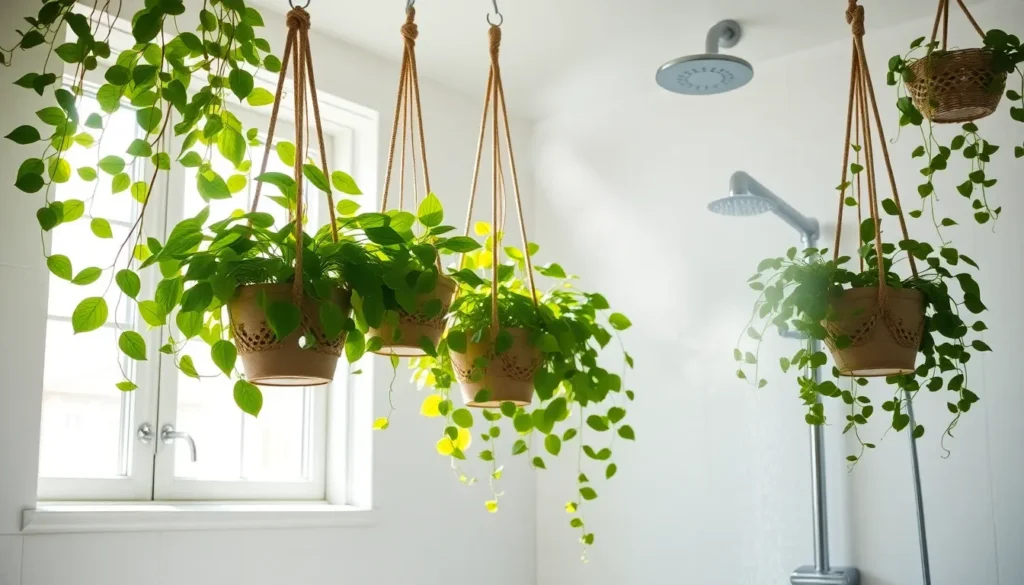We’ve all walked into a bathroom that felt more like a sterile hospital room than a relaxing sanctuary. The good news? Hanging plants can transform your bathroom from bland to breathtaking in ways you never imagined. These living decorations don’t just add visual appeal – they create a spa-like atmosphere that makes every shower feel like a mini retreat.
Bathrooms offer the perfect environment for many hanging plants to thrive. The natural humidity and warm temperatures create an ideal microclimate that tropical plants absolutely love. We’re talking about turning your bathroom into a lush oasis where you’ll actually want to spend time.
The best part? You don’t need to be a plant expert to pull this off successfully. With the right plant choices and simple hanging techniques we’ll share, you can create a stunning green sanctuary that purifies your air and elevates your daily routine.
Best Hanging Plants for Bathroom Environments
Selecting the right plants for your bathroom means choosing varieties that thrive in unique conditions. We’ve identified the top performers that’ll flourish in your humid, often dimly lit space.
Low Light Tolerant Varieties
Pothos adapts brilliantly to bathroom lighting conditions, requiring only indirect light to produce cascading vines up to 10 feet long. These hardy plants feature heart-shaped leaves in golden, marble queen, or neon varieties that create stunning visual displays from ceiling hooks or wall brackets.
ZZ Plant tolerates extremely low light conditions while maintaining its glossy, dark green foliage throughout the year. We recommend this plant for windowless bathrooms since it can survive on fluorescent lighting alone and requires watering only every 2-3 weeks.
Philodendron varieties like heartleaf and Brasil perform exceptionally well in dimly lit bathrooms, producing trailing stems that can extend 4-6 feet when properly maintained. These plants develop more vibrant coloration in bright indirect light but continue growing steadily even in darker corners.
Snake Plant thrives in low light bathroom environments while standing upright in hanging planters designed for architectural plants. This variety filters air continuously and tolerates neglect better than most houseplants, making it perfect for busy households.
High Humidity Loving Species
Boston Fern absolutely loves bathroom humidity levels, which typically range from 40-60% compared to 30-40% in other rooms. These lush plants produce delicate fronds that create a tropical atmosphere while requiring consistent moisture and warm temperatures.
Staghorn Fern mounts beautifully on bathroom walls and thrives in high humidity environments that mimic their natural rainforest habitat. We suggest placing these unique plants near shower areas where they’ll receive regular moisture from steam.
Air Plant varieties like Spanish moss and tillandsia absorb moisture directly from humid bathroom air, eliminating the need for traditional watering schedules. These plants attach to decorative holders or driftwood pieces, creating living art installations that require minimal maintenance.
Prayer Plant unfolds its decorative leaves during the day and folds them at night, responding positively to consistent bathroom humidity levels. This plant displays striking patterns in red, green, and cream colors that complement modern bathroom designs.
Air Purifying Options
Spider Plant removes formaldehyde and xylene from bathroom air while producing plantlets that create natural propagation opportunities. These plants filter air pollutants commonly found in cleaning products and personal care items used in bathrooms.
English Ivy eliminates mold spores and airborne bacteria that naturally occur in humid bathroom environments. We position these trailing plants near ventilation areas where they can process air circulation while cascading beautifully from hanging containers.
Rubber Plant removes toxins like formaldehyde from bathroom air while tolerating the temperature fluctuations that occur during hot showers. This plant features thick, glossy leaves that complement contemporary bathroom fixtures and requires watering only when soil feels dry.
Bamboo Palm filters benzene, trichloroethylene, and formaldehyde while adding tropical elegance to larger bathroom spaces. These plants grow 4-6 feet tall in hanging planters and create natural privacy screens near windows or open areas.
Creative Hanging Methods for Bathroom Plants
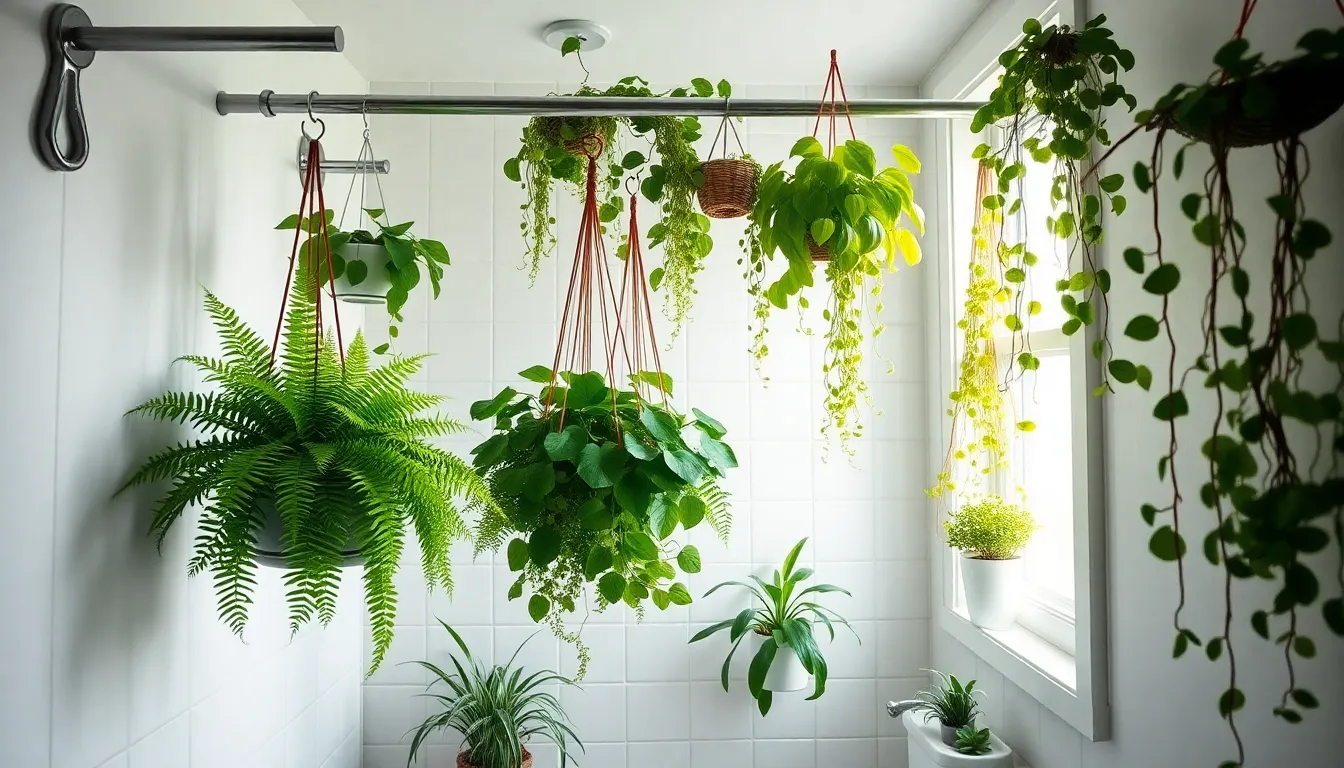
Now that we’ve covered the best plants for bathroom environments, let’s explore practical ways to display them beautifully.
Ceiling Hooks and Hardware
Ceiling installations offer the most versatile approach for hanging larger or trailing plant varieties. We recommend using toggle bolts (also called angel wing bolts) for secure mounting in drywall ceilings, as these expand behind the drywall to support weight safely. Installation involves drilling a hole and inserting the bolt, which opens up once it’s through the ceiling material.
Chain hangers provide an elegant solution for heavier plants like Boston ferns or large pothos. Rope hangers work well for rustic bathroom themes, while macramé holders add texture and visual interest. Position these ceiling hooks near shower areas where steam naturally rises, or above bathtubs where plants can benefit from the humidity.
Shower Rod Installations
Shower curtain rods double as convenient hanging spots for lightweight plant displays. We find this method particularly effective for renters who can’t install permanent fixtures. Plastic pots with drainage holes work best for this application, as they’re lightweight and won’t rust in humid conditions.
Macramé hangers excel in shower rod setups because they’re crafted from durable materials like jute, hemp, or cotton ropes. These holders distribute weight evenly and create an attractive bohemian aesthetic. Ensure your shower rod can support the additional weight by checking its mounting brackets and considering the combined weight of your plants and their containers.
Window Suction Cup Hangers
Window installations maximize natural light exposure for smaller plants while utilizing often overlooked bathroom real estate. Suction cup hooks placed directly on glass surfaces accommodate lightweight hanging baskets or small pots effectively. This positioning ensures plants receive fresh air circulation and sunlight, which is crucial for their health.
Removal and repositioning becomes effortless with suction cup systems, making them ideal for renters or those who like to rearrange their displays seasonally. Small air plants, trailing pothos cuttings, or compact spider plants work perfectly with this hanging method.
Wall-Mounted Brackets
Wall bracket systems provide permanent answers for bathroom plant displays and can support heavier containers made of concrete or ceramic materials. Individual flower pot holders mounted at varying heights create stunning vertical garden effects that transform blank walls into living art.
Shelf brackets offer additional versatility by accommodating multiple plants or combining hanging and standing displays. We suggest installing these at different levels to create visual depth and ensure each plant receives adequate light exposure. This method works particularly well for showcasing plant collections or creating structured displays rather than free hanging arrangements.
Ideal Placement Spots for Hanging Plants in Bathroom
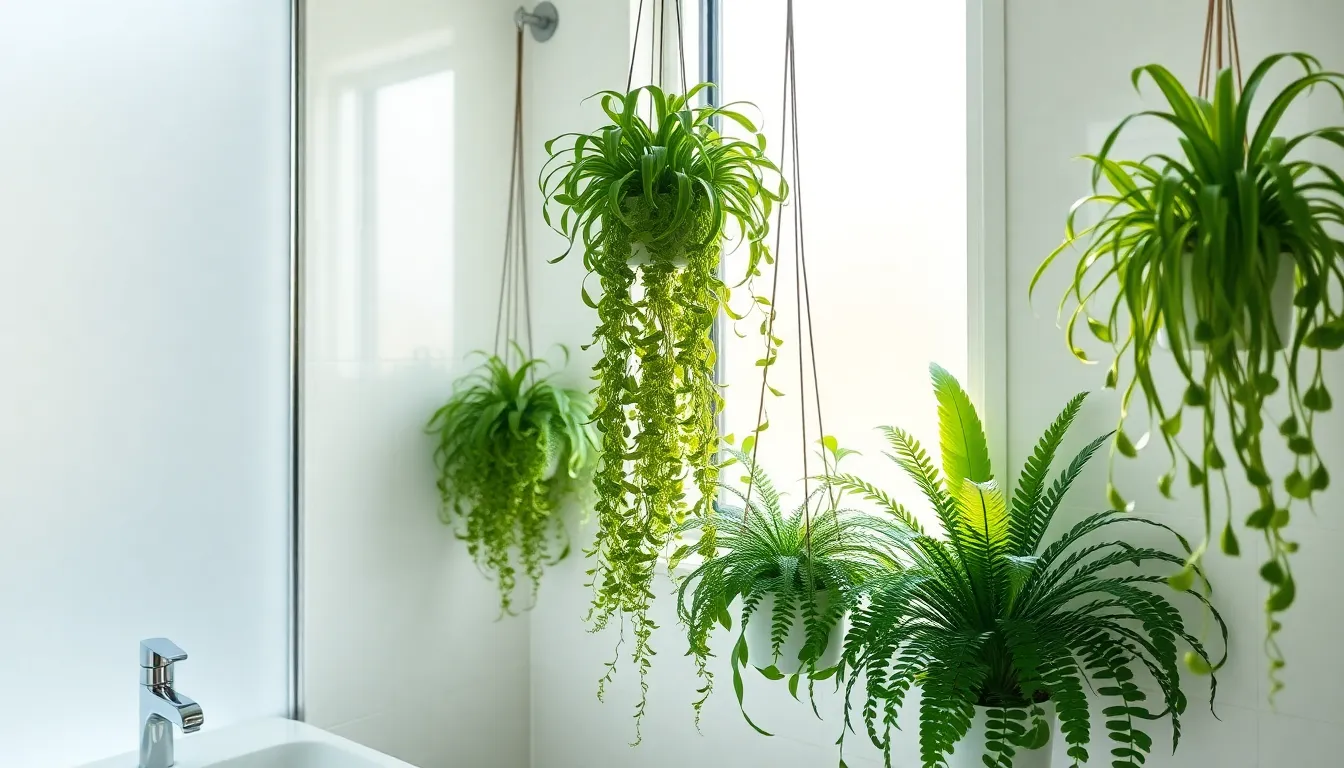
Finding the perfect spot for your hanging plants can make the difference between thriving greenery and struggling foliage. We’ll guide you through the best locations that balance light, humidity, and practicality.
Near Natural Light Sources
Positioning your plants near bathroom windows gives them the indirect natural light they crave for healthy growth. We recommend hanging Boston ferns or spider plants close to frosted glass windows where they’ll receive gentle, filtered sunlight without harsh direct rays.
Supplementing with artificial lighting works exceptionally well when natural light is limited. Wall sconces and LED strip lights can provide the additional illumination your pothos or philodendrons need to flourish in darker bathroom corners.
Curtain rods offer another strategic placement option for lightweight hanging plants. We suggest testing the rod’s weight capacity first, as some decorative rods may not support heavier planters filled with soil and water.
Away From Direct Water Spray
Protecting your plants from shower spray prevents root rot and water damage that can kill even the most resilient varieties. We place our hanging plants at least 3 feet away from direct water sources while still maintaining the humid environment they love.
Snake plants and pothos prefer this drier positioning since they’re naturally adapted to less moisture than tropical ferns. Positioning these varieties near the bathroom entrance or away from the shower enclosure gives them the perfect balance of humidity without oversaturation.
Creating a barrier using shower curtains or glass doors helps maintain optimal moisture levels. We’ve found that plants hung just outside the shower area still benefit from steam and humidity while avoiding the damaging effects of direct water contact.
Corner Positioning for Space Optimization
Corners maximize vertical space while creating dramatic visual impact in smaller bathrooms. We transform unused corner areas into lush focal points by installing ceiling hooks or wall brackets that can support trailing plants like English ivy or rubber plants.
Mounting plants in corners frees up valuable counter and shelf space for bathroom essentials. Corner placement works particularly well for air plants and prayer plants that don’t require large containers or frequent watering access.
Utilizing corner towel bars as temporary hanging spots works for lightweight plants in rental situations. We recommend testing the bar’s stability and using this method only for smaller plants like air plants or young spider plant offshoots.
Essential Care Tips for Bathroom Hanging Plants
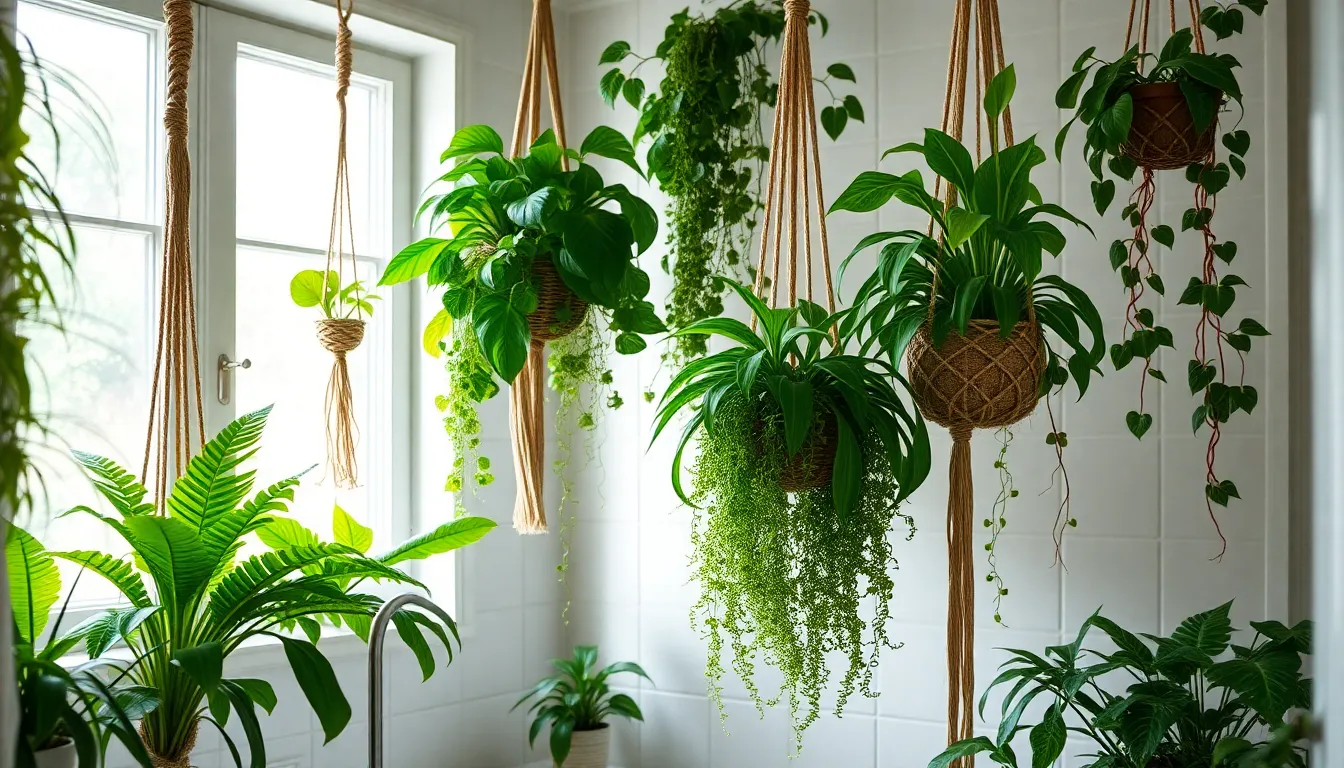
Now that you’ve selected your plants and found the perfect spots to hang them, let’s jump into the exact care requirements that’ll keep your bathroom greenery thriving in this unique environment.
Watering Schedule Adjustments
Reduce your watering frequency because bathroom humidity naturally decreases water needs compared to other houseplants. We recommend checking soil moisture by inserting your finger into the top inch of soil before watering. Most moisture-loving plants like ferns and bromeliads still need regular watering but less frequently when the soil stays consistently moist.
Monitor tropical plants weekly since species like pothos and spider plants benefit from the humid atmosphere but can suffer from overwatering. Succulents require even less water in high humidity environments and may only need watering every 2-3 weeks. We suggest using a balanced fertilizer occasionally to support healthy growth in the lower light conditions typical of bathrooms.
Adjust timing based on your bathroom usage because frequent showers create more ambient moisture that extends the time between waterings. Plants positioned closer to shower areas may need water less often than those hung near windows or farther from steam sources.
Humidity Management
Leverage natural bathroom humidity since the elevated moisture from showers and baths creates an ideal environment for tropical hanging plants. This high humidity reduces transpiration and simulates the natural habitats of plants like peace lilies and bromeliads. We’ve found that most bathroom plants thrive in humidity levels between 40-60%.
Ensure proper air circulation to prevent fungal diseases that can develop in stagnant, humid conditions. Opening bathroom doors after showers or running exhaust fans helps maintain healthy air movement around your hanging plants. Regular leaf cleaning with a damp cloth also prevents fungal issues while keeping plants looking vibrant.
Supplement with grow lights for bathrooms without windows since insufficient natural light combined with high humidity can cause leggy growth or yellowing leaves. LED grow lights positioned 12-18 inches from plants provide the spectrum needed for healthy photosynthesis in humid environments.
Drainage Considerations
Use pots with drainage holes to prevent root rot caused by waterlogged soil in high humidity conditions. We recommend lightweight materials like plastic planters or containers that won’t retain excess moisture. Never allow plants to sit in standing water, even though bathroom humidity is beneficial.
Position plants strategically so they benefit from humid atmosphere without receiving direct water spray from showers or faucets. Maintaining at least 3 feet distance from direct water sources prevents oversaturation while still providing optimal growing conditions. Macramé hangers and ceiling hooks work well for this strategic positioning.
Refresh soil periodically since bathroom conditions can compact potting mix over time due to consistent moisture exposure. We suggest repotting hanging plants annually with fresh, well-draining soil to maintain proper root health. Regular pruning of yellow or damaged leaves also promotes better air circulation and prevents pest issues in humid environments.
Safety Considerations When Hanging Plants in Bathroom
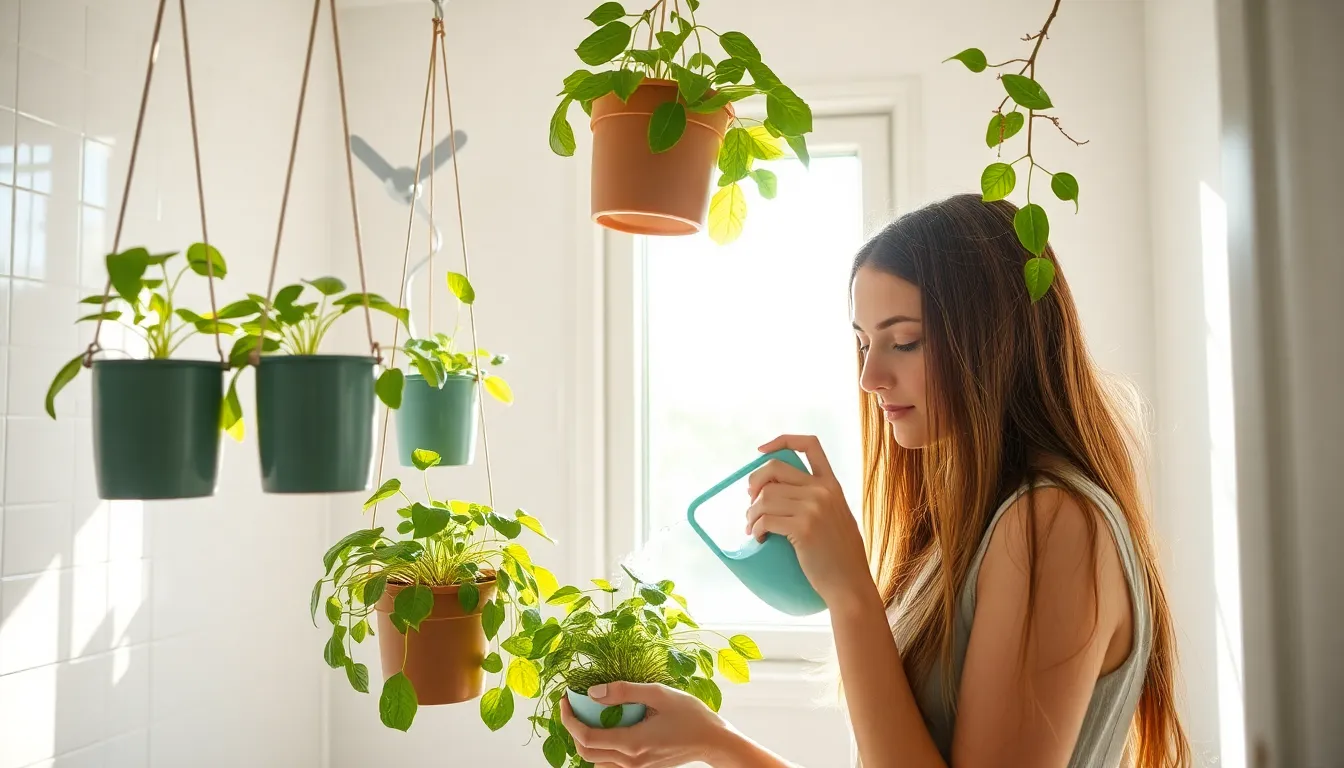
Creating a stunning plant display requires careful attention to safety measures that protect both your space and your family. We’ll cover the essential precautions to ensure your hanging garden remains beautiful and hazard-free.
Proper Weight Distribution
Mounting hardware must support the full weight of your plant, container, and wet soil combined. We recommend using lightweight plastic planters instead of ceramic or glass options to reduce the risk of dangerous falls and breakage in your bathroom environment. Secure mounting requires installation into wooden ceiling beams or wall studs rather than just drywall for reliable support.
Heavy plants need reinforced hanging systems with strong hooks rated for the exact load capacity. We suggest checking weight limits on all hardware before installation to prevent fixtures from pulling out unexpectedly. Distributing weight across multiple mounting points helps reduce stress on individual attachment points and provides extra security for larger plant displays.
Electrical Outlet Clearance
Position hanging plants well away from all electrical outlets, switches, and exposed wiring in your bathroom. We maintain safe distances because bathroom humidity and potential water drips create serious risks of electrical shock or short circuits. Accidental watering or plant maintenance can cause moisture to reach electrical fixtures if plants hang too close.
Water and electricity create dangerous combinations that require careful spacing considerations. We recommend measuring at least 3 feet of clearance between hanging plants and any electrical components to ensure safety. Positioning plants away from light switches and outlets also prevents accidental contact during daily bathroom routines.
Non-Slip Surface Maintenance
Dripping water from hanging plants can create slippery surfaces that lead to dangerous falls. We focus on positioning plants over bathtub edges or near windows where water drops won’t create hazards in high-traffic walking areas. Regular cleaning of any water that collects on countertops or floors prevents the buildup of slippery conditions.
Strategic placement reduces water accumulation in areas where people stand or walk frequently. We avoid hanging plants directly above toilet areas, vanity spaces, or main walking paths to minimize slip risks. Choosing locations that naturally contain water drops helps maintain safer bathroom conditions while still allowing you to enjoy your plant display.
Aesthetic Benefits of Hanging Plants in Bathroom Design
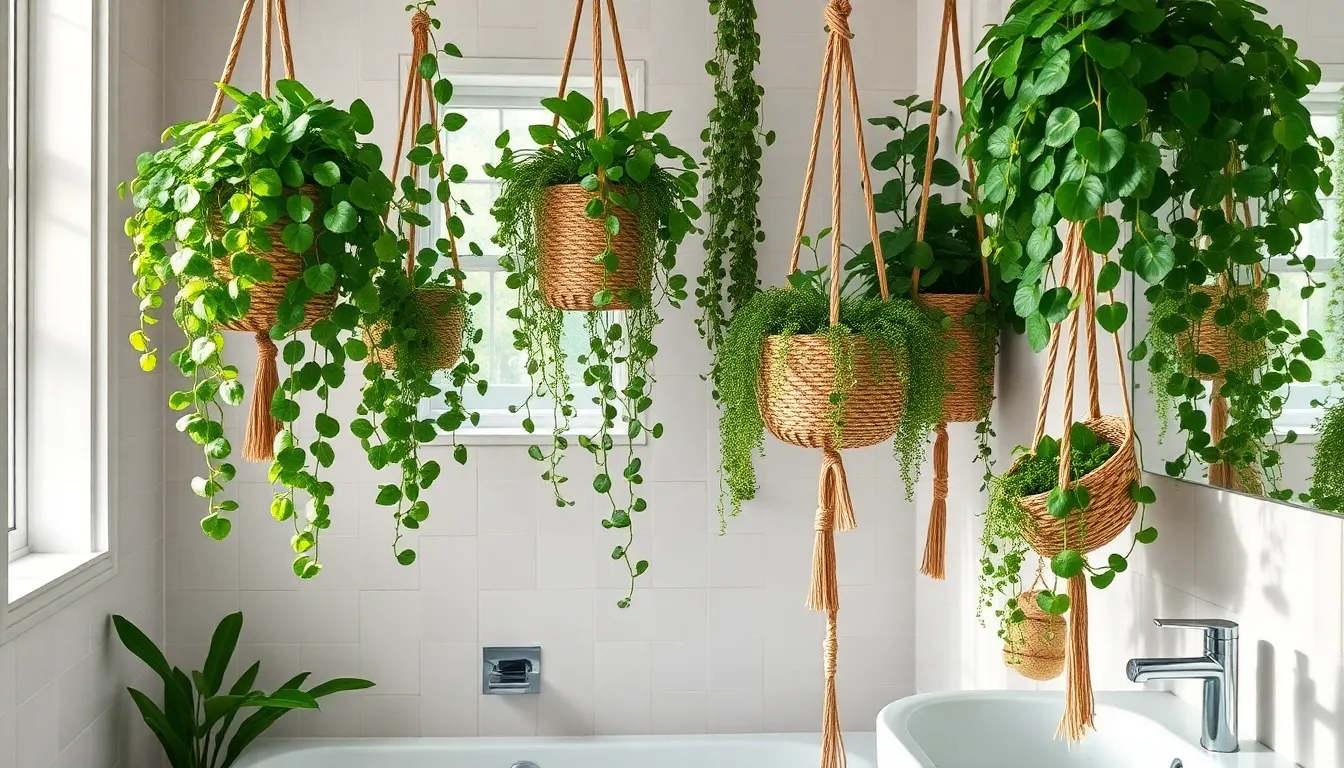
Now that we’ve covered the practical aspects of bathroom plant care and safety, let’s explore how these green additions transform your space visually.
Creating Natural Spa Ambiance
Hanging plants instantly elevate your bathroom into a calming, spa-like retreat. Natural greenery pairs beautifully with the moisture and humidity typical of bathroom spaces, creating an environment that feels refreshing and serene. Plants like eucalyptus and aloe complement this relaxing vibe perfectly, introducing organic elements that soften the clinical feel of traditional bathroom fixtures.
Steam from hot showers mingles with plant foliage to create an authentic spa atmosphere. We find that the combination of natural humidity and living plants produces that coveted resort bathroom feeling right in your own home. Air-purifying qualities of these plants also contribute to cleaner, more breathable air while you relax and unwind.
Adding Vertical Visual Interest
Vertical space utilization becomes effortless with strategically placed hanging plants. Trailing varieties such as String of Pearls and English Ivy bring elegant cascading forms that naturally draw the eye upward, making small bathrooms appear larger and more dimensional. These flowing plants soften hard lines of typical bathroom fixtures like sinks, toilets, and shower enclosures.
Layered heights create ever-changing visual depth throughout your bathroom space. Hanging plants in woven baskets or macramé planters at different elevations add textural contrast and artisanal detail. We recommend positioning taller plants near corners and shorter trailing varieties above mirrors or windows to maximize the three-dimensional effect.
Complementing Existing Decor Styles
Different plant arrangements enhance exact bathroom design themes beautifully. Each decorating style benefits from thoughtful plant selection and container choices that reinforce the overall aesthetic vision.
| Decor Style | Plant Arrangement | Container Choice |
|---|---|---|
| Bohemian/Tropical | Mix different shapes and sizes for lush atmosphere | Woven baskets, colorful ceramic pots |
| Rustic/Industrial | Natural material planters for earthy vibe | Metal containers, reclaimed wood holders |
| Coastal | Air plants and succulents with beach themes | Seashell planters, driftwood hangers |
| Modern | Minimalist geometric arrangements | Sleek white or black geometric planters |
| Vintage | Unique repurposed containers | Antique teacups, decorative birdcages |
Plant styling flexibility allows you to refresh your bathroom’s look seasonally. We’ve found that switching container materials or adding seasonal foliage creates entirely new atmospheres without major renovations. Vintage teacups work wonderfully for shabby-chic themes, while geometric planters maintain clean modern lines that complement contemporary fixtures.
Common Mistakes to Avoid With Bathroom Hanging Plants

We’ve covered the benefits and techniques for bathroom hanging plants, but success depends on avoiding common pitfalls that can harm your green oasis.
Overwatering in High Humidity
Bathrooms naturally retain moisture longer due to their high humidity environment, making overwatering the most frequent mistake we see. Soggy soil becomes a breeding ground for root rot when combined with the already moist air from daily showers and baths.
Check soil moisture before each watering session by inserting your finger one inch deep into the potting mix. Humidity loving plants like ferns and bromeliads still need careful attention to their watering schedule even though thriving in moist conditions.
Drainage holes are non negotiable for bathroom hanging plants since water needs an escape route to prevent stagnant roots. Choose pots with multiple drainage holes and use well draining potting mixes specifically designed for your plant variety.
Allow soil to dry between waterings rather than maintaining consistently wet conditions. Fungal issues develop quickly in overly moist environments, so err on the side of underwatering rather than overwatering in your bathroom sanctuary.
Choosing Wrong Plant Varieties
Succulents and cacti typically fail in bathroom environments because they’re adapted to dry conditions, not the humid atmosphere created by hot showers and steam. Desert plants struggle when forced to live in consistently moist air that contradicts their natural habitat.
Ferns excel in bathroom conditions because they naturally grow in forest understories with filtered light and high humidity. Air plants and bromeliads represent ideal choices since they absorb moisture directly from the surrounding air.
Low light tolerance becomes crucial for bathroom plants since most bathrooms receive limited natural sunlight. Plants like pothos and ZZ plants adapt well to indirect lighting conditions while maintaining their vibrant appearance.
Research your plant’s origin before bringing it into your bathroom space. Tropical varieties typically thrive in humid environments, while Mediterranean and desert plants require drier conditions found in other rooms.
Inadequate Support Systems
Heavy ceramic pots strain ceiling hooks and create safety hazards when combined with the additional weight of moist soil. Lightweight plastic planters or hanging baskets distribute weight more evenly while resisting moisture damage.
Macrame hangers offer flexibility and easy cleaning compared to metal chains that can rust in humid conditions. Moisture resistant materials like synthetic rope or plastic components last longer in bathroom environments.
Positioning matters for both plant health and safety considerations. Keep plants away from direct water spray zones like shower areas where constant moisture exposure can damage both plants and hanging systems.
Wall studs and ceiling joists provide the strongest mounting points for bathroom hanging plants. Check weight capacity before installation and consider the combined weight of pot, soil, plant, and absorbed moisture when selecting mounting hardware.
Rotate plants periodically to brighter areas if natural light becomes insufficient. Grow lights supplement inadequate lighting conditions and help maintain healthy growth patterns for your bathroom hanging garden.
Budget-Friendly Options for Hanging Plants in Bathroom
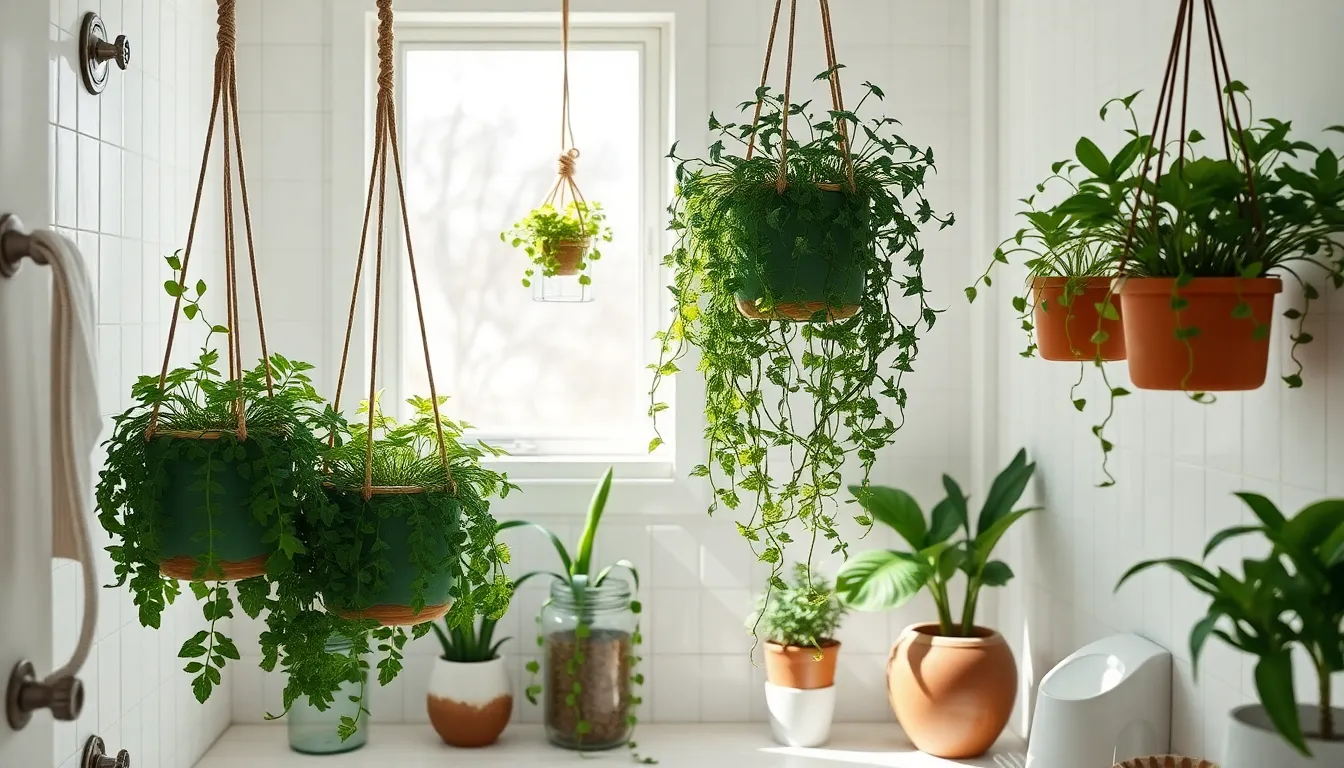
Creating a lush bathroom oasis doesn’t require very costly. We can transform our bathroom into a green sanctuary using affordable answers that maximize space and minimize costs.
DIY Hanging Answers
Macramé plant hangers offer the most cost-effective way to suspend plants while adding a personalized touch to our bathroom decor. We can create these hangers at home using simple rope or yarn, creating unique patterns that match our aesthetic preferences.
Existing bathroom fixtures provide ready-made hanging opportunities without additional hardware costs. Our shower rods and curtain rods can double as plant hanging spots, eliminating the need for new purchases while utilizing space efficiently.
Recycled materials transform into beautiful hanging planters with minimal effort and expense. We can repurpose old jars or bottles by adding drainage holes and suspending them with string or wire for an eco-friendly solution.
Heavy-duty adhesive hooks eliminate the need for drilling or complex installation procedures. These hooks provide secure mounting points for lightweight plastic planters without damaging walls or requiring professional installation.
Affordable Plant Varieties
Ferns thrive in our bathroom’s humid environment while filtering air naturally. These lush, green plants cost less than exotic varieties and create stunning hanging displays that complement any decor style.
English Ivy delivers elegant trailing foliage at budget-friendly prices while purifying our bathroom air. This low-maintenance plant requires minimal care and propagates easily, allowing us to expand our collection without additional costs.
String of Pearls provides unique visual appeal with its distinctive bead-like leaves. We can purchase starter plants affordably and watch them trail gracefully from hanging baskets as they mature.
Air Plants require no soil, making them lightweight and perfect for hanging displays. These fascinating plants absorb moisture from our bathroom’s natural humidity, reducing maintenance needs and costs.
Hoya plants offer waxy, attractive foliage that tolerates bathroom conditions exceptionally well. Their minimal soil requirements keep hanging containers light while their slow growth means less frequent repotting expenses.
Repurposed Containers and Planters
Mason jars create charming hanging planters when fitted with drainage holes and suspended using rope or wire. We can find these containers affordably at thrift stores or repurpose ones from our kitchen pantry.
Tin cans transform into rustic planters with simple modifications like drainage holes and decorative coverings. These lightweight containers work perfectly for smaller plants and cost virtually nothing to obtain.
Plastic yogurt containers provide excellent drainage when holes are added to the bottom. We can cover these containers with decorative materials like twine or fabric to create attractive planters that hide their humble origins.
Glass containers add elegance to our hanging displays while showcasing plant roots beautifully. We should position these carefully away from high-traffic areas to prevent breakage while maintaining their visual impact.
Lightweight ceramic pots offer durability and style without excessive weight that could strain hanging systems. These pots often go on sale at garden centers, making them affordable options for our bathroom plant displays.
Conclusion
We’ve shown you how hanging plants can completely transform your bathroom into a natural sanctuary that’s both beautiful and functional. With the right plant selection care techniques and hanging methods you’ll create an environment that benefits both you and your green companions.
Remember that success comes from understanding your bathroom’s unique conditions and choosing plants that actually thrive in humidity rather than just tolerate it. Whether you’re working with a tight budget or have room to splurge the key is starting small and building your collection as you gain confidence.
Your bathroom hanging garden awaits – and we’re confident you now have everything you need to create the peaceful plant-filled oasis you’ve been dreaming of.
Frequently Asked Questions
What are the best hanging plants for bathrooms?
The best hanging plants for bathrooms include Pothos, ZZ Plant, Philodendron, and Snake Plant for low-light conditions. For high humidity lovers, try Boston Fern, Staghorn Fern, Air Plants, and Prayer Plant. Air-purifying options like Spider Plant, English Ivy, Rubber Plant, and Bamboo Palm also thrive in bathroom environments due to their tolerance for moisture and varying light conditions.
How do I hang plants safely in my bathroom?
Ensure proper weight distribution by using lightweight plastic planters and secure mounting into wooden beams or wall studs. Maintain safe distance from electrical outlets and avoid placing plants where dripping water could create slippery surfaces. Use appropriate hanging hardware rated for the plant’s weight and consider the humidity’s effect on mounting materials.
Do bathroom hanging plants need different care than other houseplants?
Yes, bathroom plants require adjusted care due to high humidity. Water less frequently since natural moisture reduces their water needs. Check soil moisture before watering, ensure proper air circulation to prevent fungal diseases, and use pots with drainage holes. Monitor plants weekly and consider grow lights for windowless bathrooms.
What hanging methods work best for bathroom plants?
Effective hanging methods include ceiling hooks for lightweight plants, shower rods for temporary displays, macramé hangers for bohemian style, window suction cup hangers for small plants, and wall-mounted brackets for heavier specimens. Choose methods that complement your bathroom’s existing fixtures and ensure secure mounting for safety.
Can I create a bathroom plant display on a budget?
Absolutely! Use DIY macramé hangers made from rope or yarn, repurpose mason jars and tin cans as planters, and utilize existing shower rods for hanging displays. Heavy-duty adhesive hooks provide damage-free mounting, while affordable plants like ferns, English Ivy, and Air Plants offer low-maintenance options for budget-conscious gardeners.
Which plants should I avoid in bathroom environments?
Avoid succulents and cacti, as they don’t thrive in humid conditions and prefer dry environments. Also skip plants that require intense, direct sunlight or those sensitive to moisture fluctuations. Desert plants and those native to arid climates generally struggle in the high-humidity bathroom environment and may develop fungal issues.
How can hanging plants improve my bathroom’s appearance?
Hanging plants create a natural spa ambiance, add vertical visual interest, and make small bathrooms appear larger. Trailing varieties like String of Pearls and English Ivy provide dimensional appeal, while plants complement various decor styles from Bohemian to Modern. They offer flexible styling options for seasonal refreshes without major renovations.
What are common mistakes when growing plants in bathrooms?
Common mistakes include overwatering due to high humidity, choosing inappropriate plant varieties like succulents, using inadequate support systems, and placing plants too close to direct water spray. Also avoid using pots without drainage holes, neglecting air circulation, and positioning plants where they block natural light sources or create safety hazards.

